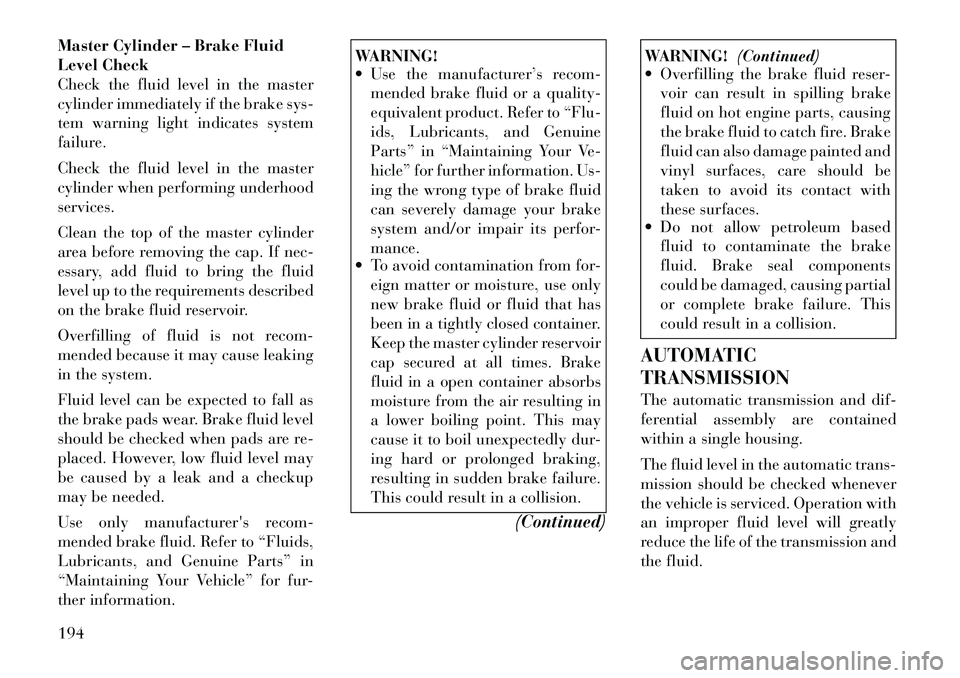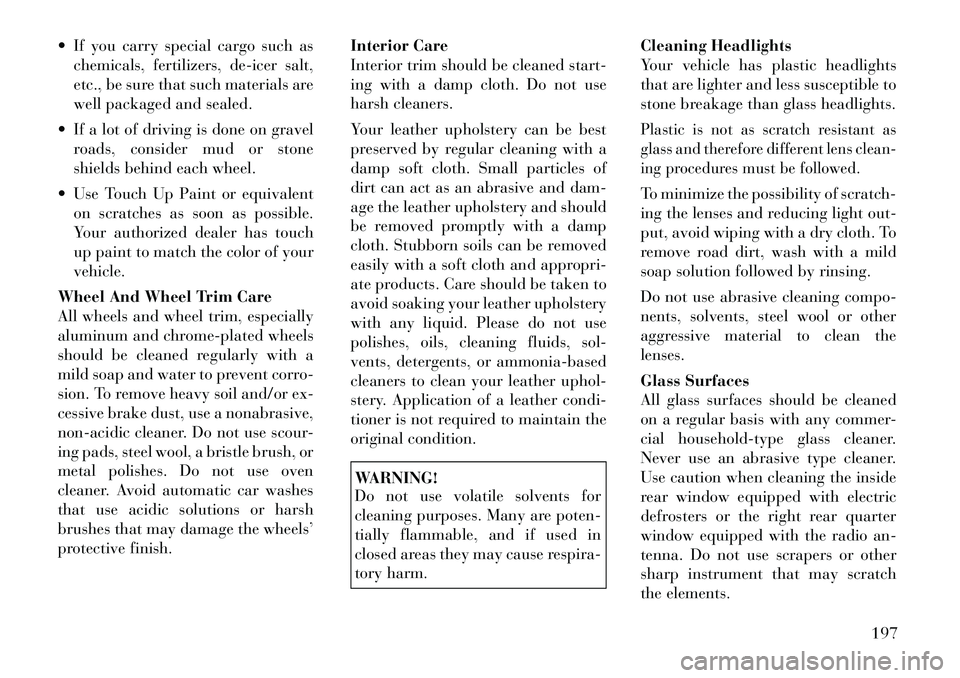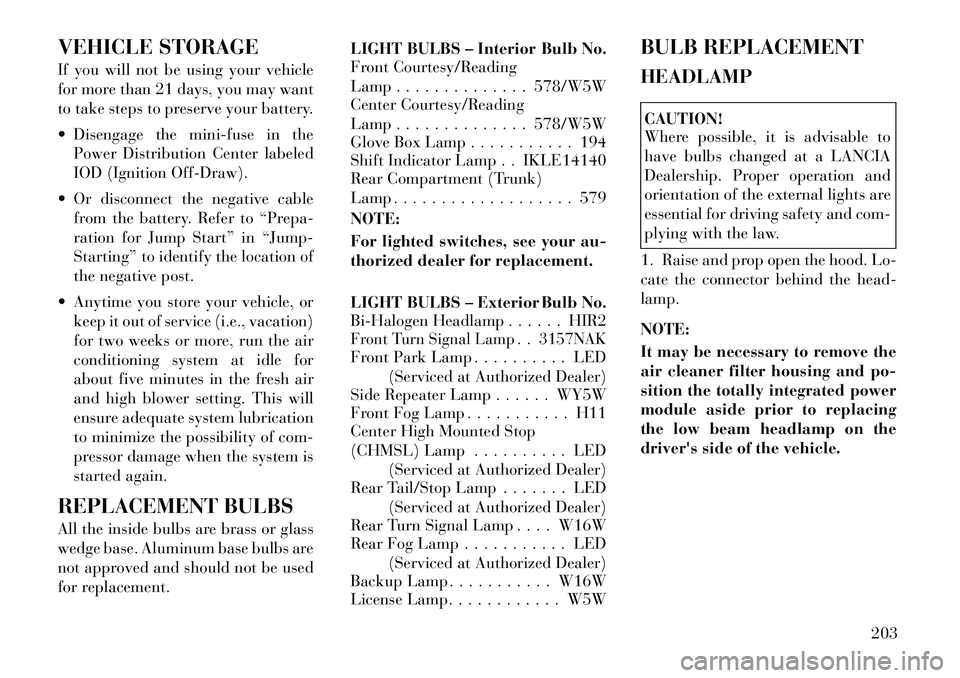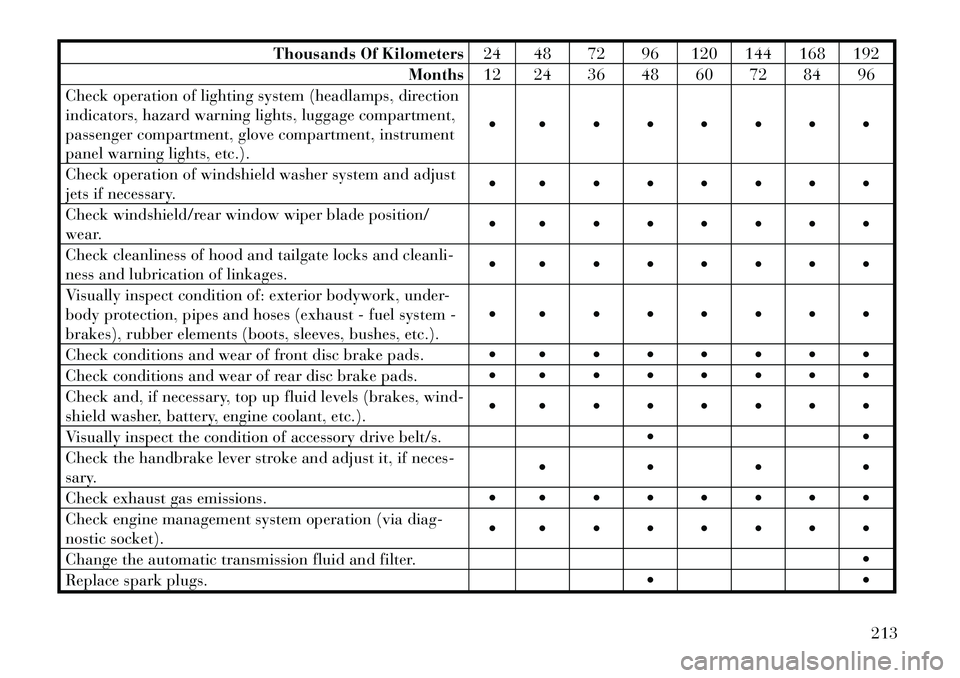light Lancia Flavia 2012 Owner handbook (in English)
[x] Cancel search | Manufacturer: LANCIA, Model Year: 2012, Model line: Flavia, Model: Lancia Flavia 2012Pages: 233, PDF Size: 2.61 MB
Page 168 of 233

NOTE:
If the gas cap is lost or damaged, be
sure the replacement cap is for use
with this vehicle.CAUTION!
Damage to the fuel system oremission control system could r e-
sult from using an improper fuel
tank filler tube cap (gas cap).
A poorly fitting gas cap may cause
the “Malfunction Indicator Light
(MIL)” to turn on.
To avoid fuel spillage and overfill-
ing, do not “top off” the fuel tank
after filling. When the fuel nozzle
“clicks” or shuts off, the fuel tank
is full.WARNING!
Never have any smoking materi-als lit in or near the vehicle when
the gas cap is removed or the tank
is being filled.
(Continued)
WARNING!(Continued)
A fire may result if gasoline is
pumped into a portable container
that is inside of a vehicle. You
could be burned. Always place gas
containers on the ground while
filling.
NOTE:
Tighten the gas cap until you hear a “clicking” sound. This is
an indication that the gas cap is
tightened properly. The MIL in
the instrument cluster may turn
on if the gas cap is not secured
properly. Make sure that the gas
cap is tightened each time the
vehicle is refueled.
When the fuel nozzle “clicks” or shuts off, the fuel tank is full.
LOOSE FUEL FILLER CAP
MESSAGE
If the vehicle diagnostic system deter-
mines that the fuel filler cap is loose,
improperly installed, or damaged, a
“CHECK GAS CAP” message will be
displayed in the EVIC (Electronic Ve-
hicle Information Center). Refer to “Electronic Vehicle Information Cen-
ter” in “Understanding Your Instru-
ment Panel” for further information.
Tighten the fuel filler cap properly
and press the odometer reset button to
turn the message off. If the problem
continues, the message will appear
the next time the vehicle is started.
Refer to “Onboard Diagnostic Sys-
tem” in “Maintaining Your Vehicle”
for further information.
NOTE:
If the gas cap is lost or damaged, be
sure the replacement cap is for use
with this vehicle.
VEHICLE LOADING
VEHICLE CERTIFICATION
LABEL
Your vehicle has a certification label
attached to the rear of the
driver's
door.
The label contains the following infor -
mation:
Name of manufacturer
Month and year of manufacture
161
Page 180 of 233

PREPARATIONS FOR
JUMP-START
The battery in your vehicle is located
between the left front headlight as-
sembly and the left front wheel splash
shield. To allow jump-starting there
are remote battery posts located on
the left side of the engine compart-
ment.WARNING!
Take care to avoid the radiatorcooling fan whenever the hood is
raised. It can start anytime the
ignition switch is on. You can be
injured by moving fan blades.
(Continued)
WARNING!(Continued)
Remove any metal jewelry such as
watch bands or bracelets that
might make an inadvertent elec-
trical contact. You could be seri-
ously injured.
Batteries contain sulfuric acid
that can burn your skin or eyes
and generate hydrogen gas which
is flammable and explosive. Keep
open flames or sparks away from
the battery.
1. Set the parking brake, shift the
automatic transmission into PARK
and turn the ignition to LOCK.
2. Turn off the heater, radio, and all
unnecessary electrical accessories.
3. Remove the protective cover over
the remote positive (+)battery post.
To remove the cover, press the locking
tab and pull upward on the cover. 4. If using another vehicle to jump-
start the battery, park the vehicle
within the jumper cables reach, set
the parking brake and make sure the
ignition is OFF.
WARNING!
Do not allow vehicles to touch each
other as this could establish a
ground connection and personal in-
jury could result.
JUMP-STARTING
PROCEDUREWARNING!
Failure to follow this procedure
could result in personal injury or
property damage due to battery ex-
plosion.
Remote Battery Posts
1 — Remote Positive (+) Post (cov-
ered with protective cap)
2 — Remote Negative (-) Post
Locking Tab
173
Page 189 of 233

ONBOARD DIAGNOSTIC
SYSTEM — OBD II
Your vehicle is equipped with a so-
phisticated onboard diagnostic sys-
tem called OBD II. This system moni-
tors the performance of the emissions,
engine, and automatic transmission
control systems. When these systems
are operating properly, your vehicle
will provide excellent performance
and fuel economy, as well as engine
emissions well within current govern-
ment regulations.
If any of these systems require service,
the OBD II system will turn on the
“Malfunction Indicator Light.” It will
also store diagnostic codes and other
information to assist your service
technician in making repairs. Al-
though your vehicle will usually be
drivable and not need towing, see
your dealer for service as soon as pos-
sible.
CAUTION!
Prolonged driving with the “Mal-function Indicator Light” on
could cause further damage to the
emission control system. It could
also affect fuel economy and
driveability. The vehicle must be
serviced before any emissions
tests can be performed.
If the “Malfunction Indicator
Light” is flashing while the engine
is running, severe catalytic con-
verter damage and power loss will
soon occur. Immediate service is
required.
REPLACEMENT PARTS
Use of genuine parts for normal/
scheduled maintenance and repairs is
highly recommended to ensure the de-
signed performance.
Damage or failures caused by the use
of parts which are not quality-
equivalent to genuine parts for main-
tenance and repairs will not be cov-
ered by the manufacturer’s warranty. MAINTENANCE
PROCEDURES
The pages that follow contain the
re-
quired maintenance services deter-
mined by the engineers who designed
your vehicle.
Besides those maintenance items
specified in the fixed maintenance
schedule, there are other components
which may require servicing or re-
placement in the future.
CAUTION!
Failure to properly maintain your vehicle or perform repairs and
service when necessary could re-
sult in more costly repairs, dam-
age to other components or nega-
tively impact vehicle
performance. Immediately have
potential malfunctions examined
by an authorized dealership or
qualified repair center.
(Continued)
182
Page 194 of 233

The A/C Air Filter is located in the
fresh air inlet behind the glove box.
Perform the following procedure to
replace the filter:
1. Open the glove box and remove all
contents.
2. Push in on the sides of the glove
box and lower the door.
3. Disconnect the glove box door
dampener from the slot on the side of
the box. This is done by grasping the
dampener connector (on the outside
of the box) and the end of the connec-
tor pin (on the inside of the box) with
your thumb and forefinger and pull-
ing outward while lightly lifting up-
ward on the door with your other
hand. Once disconnected, the damp-
ener will retract underneath the in-
strument panel if you release it.
4. Pivot the glove box downward.
5. Disengage the two retaining tabs
that secure the filter cover to the
HVAC housing and remove the cover.6. Remove the A/C Air Filter by pull-
ing it straight out of the housing.
7. Install the A/C Air Filter with the
arrow on the filter pointing toward
the floor. When installing the filter
cover, make sure the retaining tabs
fully engage the cover.
CAUTION!
The A/C Air Filter is identified with
an arrow to indicate airflow direc-
tion through the filter. Failure to in-
stall the filter properly will result in
the need to replace it more often.
8. Reinstall the glove box door damp-
ener and glove box. BODY LUBRICATION
Locks and all body pivot points, in-
cluding such items as seat tracks, door
hinge pivot points and rollers, and
hood hinges, should be lubricated pe-
riodically with a lithium based grease
to assure quiet, easy operation and to
protect against rust and wear. Prior to
the application of any lubricant, the
parts concerned should be wiped
clean to remove dust and grit; after
lubricating excess oil and grease
should be removed. Particular atten-
tion should also be given to hood
latching components to ensure proper
function. When performing other un-
derhood services, the hood latch, re-
lease mechanism and safety catch
should be cleaned and lubricated.
The external lock cylinders should be
lubricated twice a year, preferably in
the Fall and Spring. Apply a small
amount of a high quality lubricant
directly into the lock cylinder.
A/C Air Filter Replacement
187
Page 201 of 233

Master Cylinder – Brake Fluid
Level Check
Check the fluid level in the master
cylinder immediately if the brake sys-
tem warning light indicates system
failure.
Check the fluid level in the master
cylinder when performing underhood
services.
Clean the top of the master cylinder
area before removing the cap. If nec-
essary, add fluid to bring the fluid
level up to the requirements described
on the brake fluid reservoir.
Overfilling of fluid is not recom-
mended because it may cause leaking
in the system.
Fluid level can be expected to fall as
the brake pads wear. Brake fluid level
should be checked when pads are re-
placed. However, low fluid level may
be caused by a leak and a checkup
may be needed.
Use only manufacturer's recom-
mended brake fluid. Refer to “Fluids,
Lubricants, and Genuine Parts” in
“Maintaining Your Vehicle” for fur-
ther information.
WARNING!
Use the manufacturer’s recom- mended brake fluid or a quality-
equivalent product. Refer to “Flu-
ids, Lubricants, and Genuine
Parts” in “Maintaining Your Ve-
hicle” for further information. Us-
ing the wrong type of brake fluid
can severely damage your brake
system and/or impair its perfor-
mance.
To avoid contamination from for-
eign matter or moisture, use only
new brake fluid or fluid that has
been in a tightly closed container.
Keep the master cylinder reservoir
cap secured at all times. Brake
fluid in a open container absorbs
moisture from the air resulting in
a lower boiling point. This may
cause it to boil unexpectedly dur-
ing hard or prolonged braking,
resulting in sudden brake failure.
This could result in a collision.
(Continued)
WARNING!(Continued)
Overfilling the brake fluid reser-
voir can result in spilling brake
fluid on hot engine parts, causing
the brake fluid to catch fire. Brake
fluid can also damage painted and
vinyl surfaces, care should be
taken to avoid its contact with
these surfaces.
Do not allow petroleum based
fluid to contaminate the brake
fluid. Brake seal components
could be damaged, causing partial
or complete brake failure. This
could result in a collision.
AUTOMATIC
TRANSMISSION
The automatic transmission and dif-
ferential assembly are contained
within a single housing.
The fluid level in the automatic trans-
mission should be checked whenever
the vehicle is serviced. Operation with
an improper fluid level will greatly
reduce the life of the transmission and
the fluid.
194
Page 204 of 233

If you carry special cargo such aschemicals, fertilizers, de-icer salt,
etc., be sure that such materials are
well packaged and sealed.
If a lot of driving is done on gravel roads, consider mud or stone
shields behind each wheel.
Use Touch Up Paint or equivalent on scratches as soon as possible.
Your authorized dealer has touch
up paint to match the color of your
vehicle.
Wheel And Wheel Trim Care
All wheels and wheel trim, especially
aluminum and chrome-plated wheels
should be cleaned regularly with a
mild soap and water to prevent corro-
sion. To remove heavy soil and/or ex-
cessive brake dust, use a nonabrasive,
non-acidic cleaner. Do not use scour-
ing pads, steel wool, a bristle brush, or
metal polishes. Do not use oven
cleaner. Avoid automatic car washes
that use acidic solutions or harsh
brushes that may damage the wheels’
protective finish. Interior Care
Interior trim should be cleaned start-
ing with a damp cloth. Do not use
harsh cleaners.
Your leather upholstery can be best
preserved by regular cleaning with a
damp soft cloth. Small particles of
dirt can act as an abrasive and dam-
age the leather upholstery and should
be removed promptly with a damp
cloth. Stubborn soils can be removed
easily with a soft cloth and appropri-
ate products. Care should be taken to
avoid soaking your leather upholstery
with any liquid. Please do not use
polishes, oils, cleaning fluids, sol-
vents, detergents, or ammonia-based
cleaners to clean your leather uphol-
stery. Application of a leather condi-
tioner is not required to maintain the
original condition.
WARNING!
Do not use volatile solvents for
cleaning purposes. Many are poten-
tially flammable, and if used in
closed areas they may cause respira-
tory harm.Cleaning Headlights
Your vehicle has plastic headlights
that are lighter and less susceptible to
stone breakage than glass headlights.
Plastic is not as scratch resistant as
glass and therefore different lens clean-
ing procedures must be followed.To minimize the possibility of scratch-
ing the lenses and reducing light out-
put, avoid wiping with a dry cloth. To
remove road dirt, wash with a mild
soap solution followed by rinsing.
Do not use abrasive cleaning compo-
nents, solvents, steel wool or other
aggressive material to clean the
lenses.
Glass Surfaces
All glass surfaces should be cleaned
on a regular basis with any commer-
cial household-type glass cleaner.
Never use an abrasive type cleaner.
Use caution when cleaning the inside
rear window equipped with electric
defrosters or the right rear quarter
window equipped with the radio an-
tenna. Do not use scrapers or other
sharp instrument that may scratch
the elements.
197
Page 207 of 233

WEATHER STRIP CARE –
SOFT AND HARD TOP
Lubricate all top and door glass
weather strips periodically with a
weather strip lubricant to keep them
soft and pliable.FUSES
INTEGRATED POWER
MODULE
The Integrated Power Module is lo-
cated in the engine compartment near
the air cleaner assembly. This center
contains cartridge fuses and mini
fuses. A label that identifies each
component may be printed on the in-
side of the cover. Refer to the graphic
below for FUSES/TIPM location.
Cavity
Cartridge Fuse Mini Fuse Description
1 40 Amp Green —Power Top Module
2 —20 Amp Yellow Brake Vacuum Pump
3 —10 Amp RedCenter High Mounted Stop Light (CHMSL)/
Brake Switch
4 —10 Amp Red Ignition Switch
5 —20 Amp Yellow Trailer Tow (when present)
6 —10 Amp Red Power Mirror Switch/Climate Controls
7 —30 Amp Green Ignition Off Draw (IOD) Sense 1
8 —30 Amp Green Ignition Off Draw (IOD) Sense 2
9 40 Amp Green Battery Feed – Power Seats (for versions/
markets, where provided)
10 —20 Amp Yellow Instrument Panel/Power Locks/Interior
Lights
11 —15 Amp Lt Blue Selectable Power Outlet (Inside Center Arm
Rest)
12 —20 Amp Yellow —
13 —20 Amp Yellow Ignition/Cigar Lighter
Integrated Power Module
200
Page 210 of 233

VEHICLE STORAGE
If you will not be using your vehicle
for more than 21 days, you may want
to take steps to preserve your battery.
Disengage the mini-fuse in thePower Distribution Center labeled
IOD (Ignition Off-Draw).
Or disconnect the negative cable from the battery. Refer to “Prepa-
ration for Jump Start” in “Jump-
Starting” to identify the location of
the negative post.
Anytime you store your vehicle, or keep it out of service (i.e., vacation)
for two weeks or more, run the air
conditioning system at idle for
about five minutes in the fresh air
and high blower setting. This will
ensure adequate system lubrication
to minimize the possibility of com-
pressor damage when the system is
started again.
REPLACEMENT BULBS
All the inside bulbs are brass or glass
wedge base. Aluminum base bulbs are
not approved and should not be used
for replacement. LIGHT BULBS – Interior Bulb No.
Front Courtesy/Reading
Lamp . . . . . . . . . . . . . . 578/W5W
Center Courtesy/Reading
Lamp . . . . . . . . . . . . . . 578/W5W
Glove Box Lamp . . . . . . . . . . . 194
Shift Indicator Lamp . . IKLE14140
Rear Compartment (Trunk)
Lamp . . . . . . . . . . . . . . . . . . . 579
NOTE:
For lighted switches, see your au-
thorized dealer for replacement.
LIGHT BULBS – Exterior Bulb No.
Bi-Halogen Headlamp . . . . . . HIR2
Front Turn Signal Lamp . . 3157NAKFront Park Lamp . . . . . . . . . . LED
(Serviced at Authorized Dealer)
Side Repeater Lamp . . . . . . WY5W
Front Fog Lamp . . . . . . . . . . . H11
Center High Mounted Stop
(CHMSL) Lamp . . . . . . . . . . LED
(Serviced at Authorized Dealer)
Rear Tail/Stop Lamp . . . . . . . LED
(Serviced at Authorized Dealer)
Rear Turn Signal Lamp . . . . W16W
Rear Fog Lamp . . . . . . . . . . . LED
(Serviced at Authorized Dealer)
Backup Lamp . . . . . . . . . . . W16W
License Lamp. . . . . . . . . . . . W5W BULB REPLACEMENT
HEADLAMP
CAUTION!
Where possible, it is advisable to
have bulbs changed at a LANCIA
Dealership. Proper operation and
orientation of the external lights are
essential for driving safety and com-
plying with the law.
1. Raise and prop open the hood. Lo-
cate the connector behind the head-
lamp.
NOTE:
It may be necessary to remove the
air cleaner filter housing and po-
sition the totally integrated power
module aside prior to replacing
the low beam headlamp on the
driver's side of the vehicle.
203
Page 212 of 233

REAR TURN SIGNAL
LAMPS
1. Open the trunk and gently pull
back the trunk liner behind the tail
lamp (requires removal of a push pin
holding the trunk trim in place near
the tail lamp).
2. Remove the two plastic wing nuts
from the tail lamp housing.
NOTE:
Placing a small flat head screw-
driver or similar tool between the
lamp outboard ball stud and plas-
tic grommet from inside the trunk
can help to disengage the outboard
edge of the tail lamp.
3. Grasp the tail lamp by both the
outboard and inboard sides, and pull
firmly to disengage the tail lamp from
the vehicle.NOTE:
It is normal to hear a loud sound
when the lower tail lamp area un-
snaps from the vehicle mounting
bracket during tail lamp removal.
4. Twist and remove socket from
lamp.
5. Remove bulb from socket and re-
place.
6. Reinstall the tail lamp, fasteners,
and trunk liner.
BACKUP LAMP
1. Remove four push pins from the
bottom of the lower valance (from left
to right: 1st, 3rd, 6th & 8th) and two
push pins from the rear of the bracket.
2. Remove bracket by pulling for-
ward of vehicle.
3. Remove socket from housing with
a counter-clockwise
1�4turn.
4. Remove bulb from socket by pull-
ing directly out (do not turn/twist)
and install replacement bulb.
5. Insert socket back into the housing
with a clockwise
1�4turn.
6. Return bracket into position.
7. Snap the six (6) push pins back
into place.
LICENSE PLATE LAMP
1. Using a small screwdriver, press
inward the locking tab on the side of
the lamp assembly and pull down on
the lamp assembly for removal.
2. Remove bulb socket by twisting
out of lamp assembly.
3. Pull bulb from socket, replace, and
reinstall the bulb socket into lamp
assembly.
4. Install lamp assembly to lightbar
ensuring the locking tab is secure.
205
Page 220 of 233

Thousands Of Kilometers24 48 72 96 120 144 168 192
Months 12 24 36 48 60 72 84 96
Check operation of lighting system (headlamps, direction
indicators, hazard warning lights, luggage compartment,
passenger compartment, glove compartment, instrument
panel warning lights, etc.).
Check operation of windshield washer system and adjust
jets if necessary.
Check windshield/rear window wiper blade position/
wear.
Check cleanliness of hood and tailgate locks and cleanli-
ness and lubrication of linkages.
Visually inspect condition of: exterior bodywork, under-
body protection, pipes and hoses (exhaust - fuel system -
brakes), rubber elements (boots, sleeves, bushes, etc.).
Check conditions and wear of front disc brake pads.
Check conditions and wear of rear disc brake pads.
Check and, if necessary, top up fluid levels (brakes, wind-
shield washer, battery, engine coolant, etc.).
Visually inspect the condition of accessory drive belt/s.
Check the handbrake lever stroke and adjust it, if neces-
sary.
Check exhaust gas emissions.
Check engine management system operation (via diag-
nostic socket).
Change the automatic transmission fluid and filter.
Replace spark plugs.
213